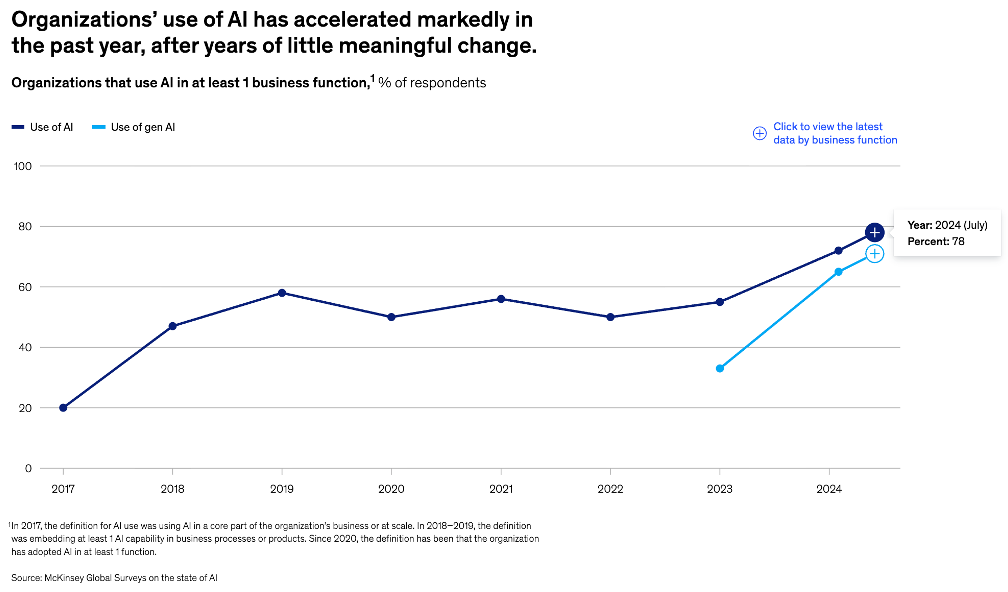AI has entered the enterprise with speed and optimism. It drafts content, summarizes documents, writes code, and can initiate actions across business systems. Because of this momentum, many assume AI is on track to automate entire business processes and make organizational decisions without any human interaction.
Inside organizations, the reality looks different: AI is reducing manual effort, not removing the process itself.
Workflow automation continues to determine how work moves through the business, who is responsible for key decisions, and how accountability and approvals are captured. AI may take on parts of the work inside the workflow system – reading documents, extracting data, or suggesting actions – but the workflow itself still determines what happens, who owns the decision, and when to move forward.
Adoption is accelerating quickly. According to McKinsey’s 2025 State of AI research, 78% of organizations now use generative AI in at least one business function.

The concentration of that usage tells an important story. AI is used heavily in areas like marketing, content development, and IT support because the work is informational and experimenting with output has little operational risk. If an AI-generated draft isn’t perfect, the stakes are low and there is an expectation that the output, such as images or text, will go through further review and a few iterations.
McKinsey’s function level data reveal that certain processes, especially financial approvals, compliance workflows, inventory routing, and regulated operations, remain largely unaffected by AI.These areas are not falling behind; they are deliberately protected because the work requires specific outcomes and documented accountability.
In processes with financial exposure, legal risk, or strict compliance requirements, organizations depend on traceability and clear ownership of decisions. AI can support tasks such as reading documents or extracting data, but the responsibility for judgment and the defensible record of who approved what and when must remain within the workflow and with the people accountable for it.
Many people use the term “AI automation” as if it represents one concept, but in practice, AI and workflow automation serve different purposes within the same process. The latter moves work from step to step, assigns responsibility, enforces rules, and creates an audit trail of what occurred while the former performs a single activity within a step, like analyzing information, extracting data or suggesting a response.
A clear example is hiring. AI can scan resumes, extract skills, match them to job requirements, and produce concise summaries for reviewers, but the workflow still determines who reviews the candidate, when interviews happen, and how decisions are documented. AI may accelerate screening, yet it cannot evaluate cultural fit, assess judgement during an interview, or make a hiring decision. The system routes the work, tracks tasks,and captures accountability, but humans make the final call.
In structured business processes, automation governs the movement and accountability, while AI enhances efficiency inside individual steps.
McKinsey’s report Rewired and Running Ahead: Digital and AI Leaders Are Leaving the Rest Behind highlights that organizations seeing real financial results from AI began by improving their processes. They established clarity around decision-making, streamlined how work moved through the organization, and reduced friction before layering AI on top.
AI amplifies well-defined processes. It does not fix unclear ones.
Organizations that struggle with process clarity see little benefit from AI because speeding up an unclear workflow only moves work faster into the same bottlenecks.
ServiceNow’s Enterprise AI Maturity Index 2025 addresses a newer phase of AI where models do more than generate content – they take action inside systems. Even with all the enthusiasm surrounding AI, adoption here is still early and only a small segment of organizations has a working example in production. Many of these platforms also package AI into purpose-built solutions that insert AI into multiple activities across a process, which can give the impression that AI automates the workflow itself.
The companies that do have these use cases in place tend to have one shared trait: they already operate with clearly defined workflows.Decision points are understood, rules are explicit, and routing is consistent.Because of that structure, introducing AI into specific steps becomes significantly less risky.
Large enterprises can experiment with AI. They have innovation budgets, data teams and room to test ideas that may or may not deliver immediate value.
Most small and mid-sized organizations operate differently.They prioritize initiatives that produce predictable gains and minimize disruption. Workflow automation fits that need because it is built on the business rules the organization already understands. It improves execution simply by reducing handoffs, clarifying ownership and ensuring work moves when and where it should.
Many of the efficiency gains companies associate with AI appear as soon as the process becomes consistent.
Once the workflow is stable, adding AI becomes easier because every step has a defined purpose and an identified owner.
When organizations say they want AI to “automate the work,”the underlying problem is often that the workflow itself lacks definition. Work slows down because responsibilities are unclear or information is missing when someone finally receives a task. AI cannot correct those issues. Only process design can.
Once routing and ownership are clear, AI can be applied with intent. Tasks that require interpretation or analysis can benefit from AI while repetitive routing and approvals can be handled by workflow.
In practice, the most effective pattern emerging in organizations looks like this:
This combination produces efficiency without losing control or traceability.
AI is transforming how individual tasks are completed, but it does not replace the need for defined processes. It does not determine responsibility, enforce compliance or maintain an audit trail.
Workflow automation continues to be the backbone of structured work.
AI enhances processes. Workflow governs them.
Organizations that invest in workflow first get more value from AI when they introduce it, because the system around the work is ready to support it.